Fixed incomes and unsustainable cost-of-living increases have pushed many older adults further into food insecurity and isolation. In New York City, meal delivery services provide a lifeline.
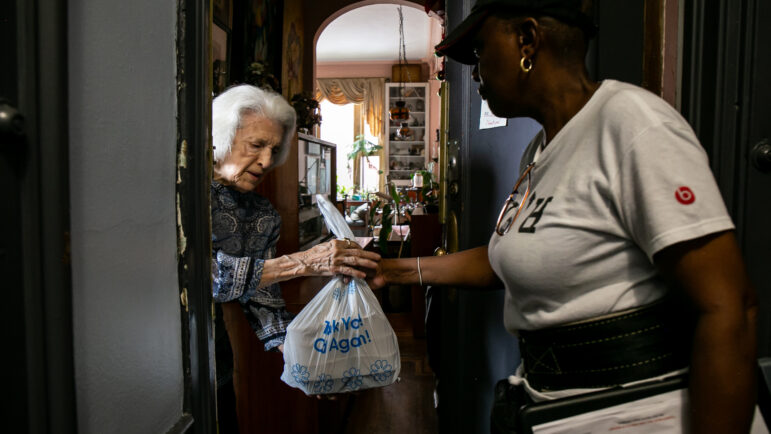
Adi Talwar
Mary Blake, 95, receiving meals from Encore staffer Allison Anthony on July 31, 2024.
At Euclid Hall in Manhattan, a senior housing facility, Andre Domerson, 85, carefully rationed the free lunch he got: microwave the takeout white container with eggplant chickpea stew, brown rice, and steamed cauliflower for lunch, and refrigerate the small milk box, apple, and piece of bread for breakfast the following morning.
A social worker would bring him food for dinner, Domerson told City Limits, and he planned to keep some of the meal to last him through the weekend. During a reporter’s recent visit this summer, the mini refrigerator in his apartment contained two eggs, a piece of bread, and some milk in a mug from previous days.
Domerson got the lunch from Encore Community Services, an organization that offers meals and other care to older New Yorkers. “I am a sick person…That’s why I like it [the meals] because it’s clean. It’s also healthy and it comes with dates,” he said, pointing at the label indicating the day the food was prepared.
Domerson said he suffers from hypertension, hyperlipidemia, and hypothyroidism. He migrated to the U.S. at the age of 46 from Haiti, and spent his life working in a furniture store in the city. After retirement, he made the U.S. his home, as all of his family members back in Haiti had died in the earthquake there in 2010, he said.
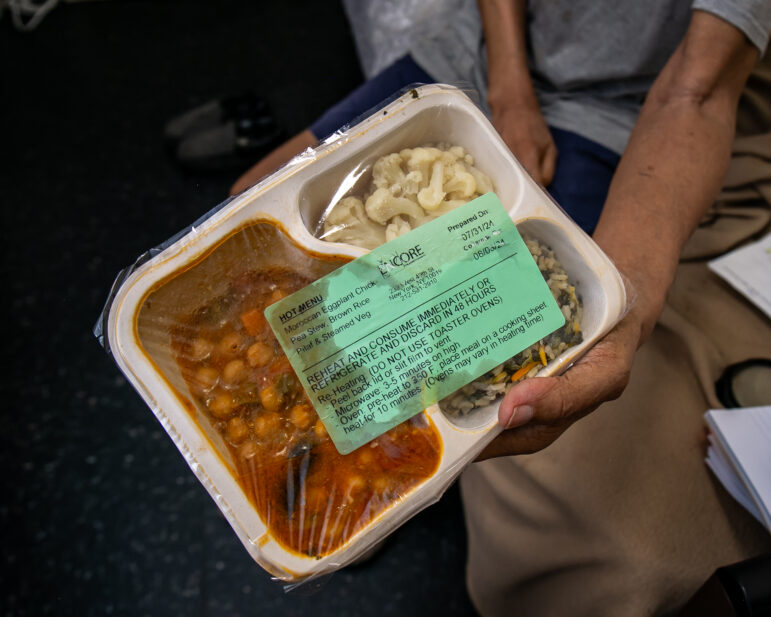
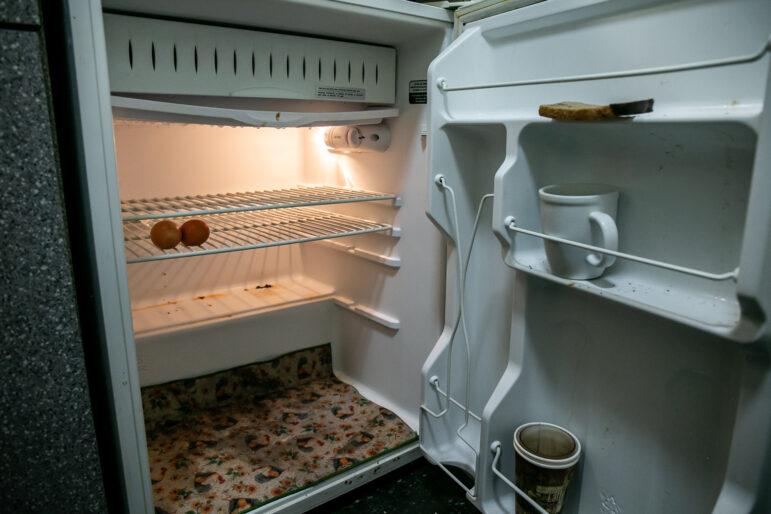
Left: Andre Domerson holding a meal he received from Encore. Right: Domerson’s near-bare refrigerator.
Photos by Adi Talwar.
Older adults like Domerson are vulnerable to food insecurity for many reasons. A 2023 survey by the CUNY Urban Food Policy Institute and Citymeals on Wheels found that 65 percent of respondents—participants who receive food through the city’s delivery program or at its older adult centers—were earning less than $15,000 annually. At the same time, the cost of food increased by nearly 6 percent.
“We know that a major barrier to accessing healthy food for many New Yorkers is cost, most older adults are on a fixed, limited income,” Katy Tomaino Fraser, director of evaluation at CUNY Urban Food Policy Institute, stated in an email.
“On top of that you factor in the age related physical and mental challenges that many older adults face in procuring and then preparing food for themselves,” she added.
Indeed, stagnant wages and unsustainable increases in living costs has led to over a million more monthly visits to New York City food pantries and soup kitchens now compared to 2019, according to food rescue group City Harvest. In the state of New York, more than 7.8 percent of older residents lived in food insecure households in 2022.
Addressing some of these concerns locally, the city’s latest fiscal year 2025 budget restored $4.75 million for NYC Aging to cover the costs of home-delivered meals, such as those Domerson receives.
But advocates say the current offerings remain inadequate to address the dire needs among older adults. In fact, 60 percent of homebound older residents receiving meals at home in the city reported they were still food insecure, the 2023 survey found.
“The city should provide three meals a day to older New Yorkers who need it, who cannot leave their homes, and live alone,” said Jeremy Kaplan, executive director at Encore Community Services. Currently, Encore provides one meal a day for seven days, out of which the city funds five meals; two meals are funded by Citymeals on Wheels.
“Neither meals are funded at a rate that fully covers the cost of the program,” Kaplan added.
During the most recent fiscal year that ended in June, NYC Aging served 24,572 clients through its home-delivered meals program, down from 27,547 the year before, according to the Mayor’s Management Report—a dip the agency attributed to “provider transition and staffing deficits,” as well as state guidance around Managed Long-Term Care that “rendered many clients ineligible.”
“NYC Aging has since received further clarification on these guidelines from the State and is now able to re-enroll those clients,” the report says.
In a statement to City Limits, NYC Aging Commissioner Lorraine Cortés-Vázquez pointed to the millions of additional dollars allocated in the current fiscal year budget to home-delivered meals, which she called “a vital part of our efforts to help ensure homebound older adults can continue to age-in-place with dignity and respect.”
“If the number of meals delivered does not meet the specific need of an HDM [home-delivered meal] client, our service providers will work to find and refer the client to programs that can assist them with accessing additional meals and supports,” Cortés-Vázquez added.
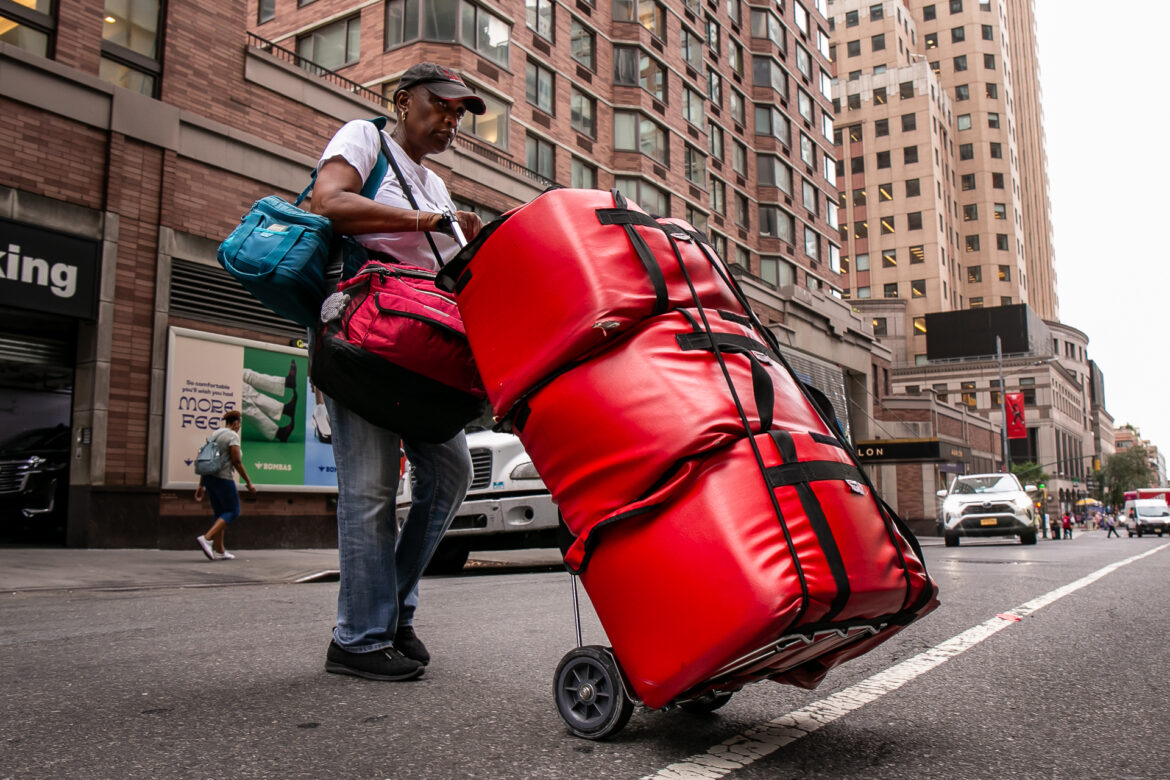
Adi Talwar
Allison Anthony has been delivering senior meals for more than a decade.‘To have somebody come in and check on her‘
Back at the basement of Encore’s Senior Center in Midtown Manhattan on a recent summer weekday, Allison Anthony, who has been delivering meals for the organization for over 15 years, started her work at 7 a.m.
She placed the meal packages in bags, then put them inside insulated 30-pound delivery bags. By 10 a.m., she loaded them onto a trolley, stocked them in a van, and was out for delivery. She wore a thick black belt around her waist to help prevent back pain.
Anthony told City Limits that she doesn’t just hand over meals, but also checks on the older adults, who often live by themselves.
“Once I got to our client and she fell on the floor behind the door. And I called the office [Encore], then called 911,” she recalled of one incident. “Thankfully that day her grandson was also with her inside the apartment and we managed to avoid any untoward incident.”
Domerson, in the senior housing facility, also looked forward to Anthony coming, not just for the meals, but for the chit-chat. Other times, Anthony said older adults on the street stop her to ask about the meals, and she informs them about how to apply. On average, Anthony delivers meals for up to 30 clients a day.
On a reporter’s recent visit, they included Mary Blake, 95, an author living on the Upper West Side. Outside her door, she posted a sticky note that read, “I’m here. Please ring three times or call,” along with her phone number.
Blake started getting the home-delivered meals from Encore after she broke her pelvis in 2016, when “the surgeon botched the job and left a screw sticking out that was stabbing a nerve,” she said.
“It was like it was having a root canal in my hip. It was nerve pain beyond belief, and I didn’t even sleep for a year and a half. I couldn’t lie down, I couldn’t sit up, I couldn’t crawl, I couldn’t do anything without excruciating pain,” she added.

Adi Talwar
Royal Alvis and Allison Anthony loading Alvis’ car for food deliveries on July 31, 2024.She said she freezes the delivered meals, and pops them in the oven when she’s ready to eat. “I do what my grandmother used to call, I doctor it up. I put herbs and spices, a little bit of this, and a little bit of that,” she said. The meals had improved recently, she said; some of her favorites were baked fish, lentil stew, and barbecue chicken.
Another deliver worker who’s been with Encore since 2020 is volunteer Royal Alvis, 57. “My mom lived in North Carolina and she started receiving meals on deliveries like this, and that made a big difference to her, to have somebody come in and check on her and just to have the meals over there,” he said, when asked what inspired him to help out.
His mother, currently 96, lives in a care facility in New Jersey now. Some of the clients he delivers to are also in need of a care facility but want to hang onto their homes and their independence, he said.
“There was one lady, she had a lot of roaches in her place. Every time you knocked on the door, the roaches ran in all directions,” he said. While the client had a family member come in and clean once in a while, it wasn’t enough to get rid of the bugs.
For the most part, Alvis said the clients like the meals, and some even thought they were “restaurant quality.” Some are just happy to have someone knock on their door and chat.
Dr. Ademola Ladapo is a geriatric psychiatrist at Elmhurst Hospital in Queens, which serves one of the highest populations of older adults in the city. He explained that after retirement, older adults tend to face social isolation and can no longer navigate the city with the same ease. They often have financial concerns, their living conditions change, or they lack access to services.
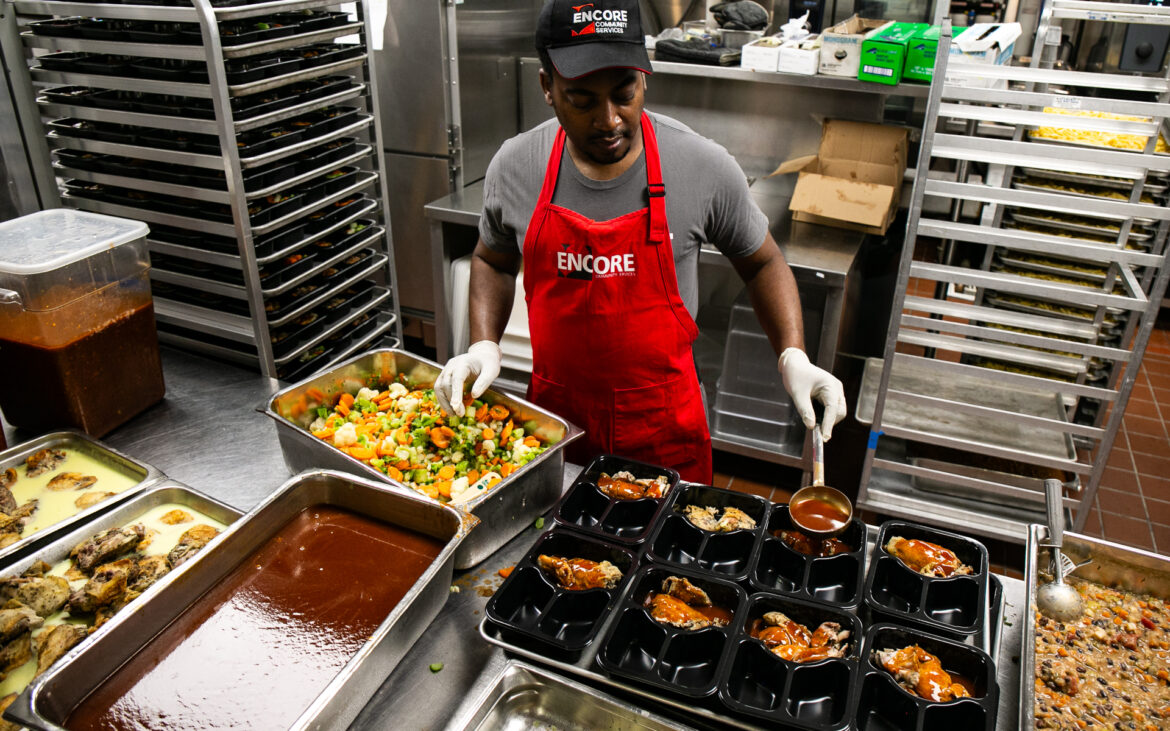
Adi Talwar
Meals for clients being prepared at Encore’s Senior Center in Manhattan.“Most of the elderly population have physical disabilities and chronic health issues. The physical ailment worsens mental health as they become dependent on assistance devices and lose independence,” said Dr. Ladapo.
Food insecurity can increase their stress, anxiety and depression. “It exacerbates both the underlying mental health and also their physical health,” he said.
In New York City, 45 percent of people aged 60 and older live alone, a risk factor for social isolation. Citing their study “Aging Without Hunger,” Fraser from CUNY Urban Food Policy Institute said that the older adults they surveyed reported not having family or friends who could provide them meals at least once a day, and described cooking as a “hassle.”
“[They] spoke at length about the mental effort required to prepare a healthy meal, including planning to have the right ingredients, being conscious of health conditions, and considering all the steps needed to prepare something,” Fraser said in a statement
Cathy Agosto, 76, another client who receives Encore’s meals, said she was grateful to get them as she “never enjoyed cooking.” She got four meals at once so that she could freeze them for the next few days. “Once I finish the frozen food I eat the stuff in the pantry, and if I run out of that, then I have candies and a lot of coffee,” she said.
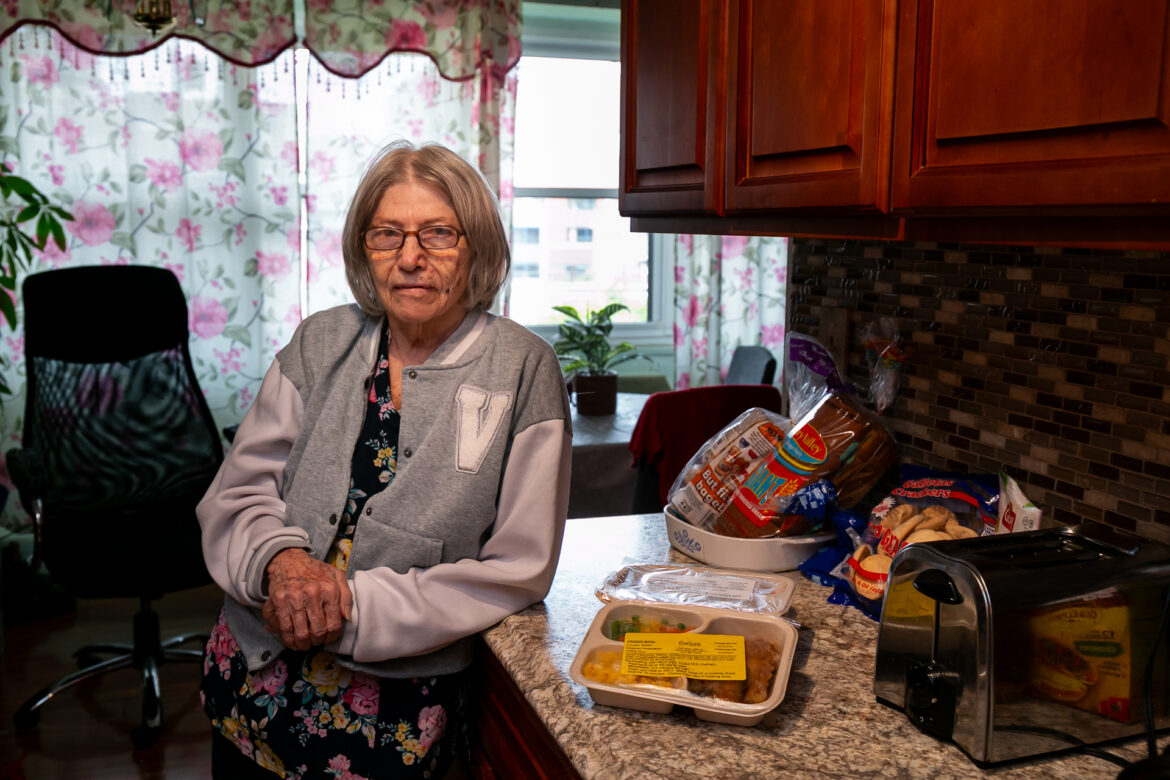
Adi Talwar
Cathy Agosto, 76, in her Upper West Side apartment. Encore delivers frozen meals twice a week; she said she appreciates the meals since she does not enjoy cooking.Citymeals on Wheels has been working to fill the gaps for older adults by providing meals on weekends, holidays, and during emergencies, like harsh winter weather, according to Beth Shapiro, CEO of the organization.
The organization also provides a second meal, which includes breakfast, a 30-day supply of morning staples, frozen meals, and groceries. Despite these efforts, Shapiro said that while the recipients appreciate the program, they often felt it just did not go far enough.
“Older New Yorkers have nutritional needs that are broader and more diverse than the city’s current food programs were designed to address. A range of solutions are needed to provide more food, meet their actual nutritional needs and move away from a one-size-fits all program for older adults,” she said in a statement.
Shapiro called for urgent investment in home-delivered meal systems, from upgrading kitchen and delivery vehicles to funding for more case management.
Back at the senior housing facility, Domerson said he is very comfortable where he is. “But I wish there were more meals,” he said. “It’s not enough for me in the mornings and on the weekends.”
This story has been updated to correct an organization’s name: it is Citymeals on Wheels, not City Meals on Wheels. We’ve also updated photo captions that incorrectly identified Anthony as a volunteer with Encore Community Services; she is an employee there.
To reach the reporter behind this story, contact Subeksha@citylimits.org. To reach the editor, contact Jeanmarie@citylimits.org
Want to republish this story? Find City Limits’ reprint policy here.








